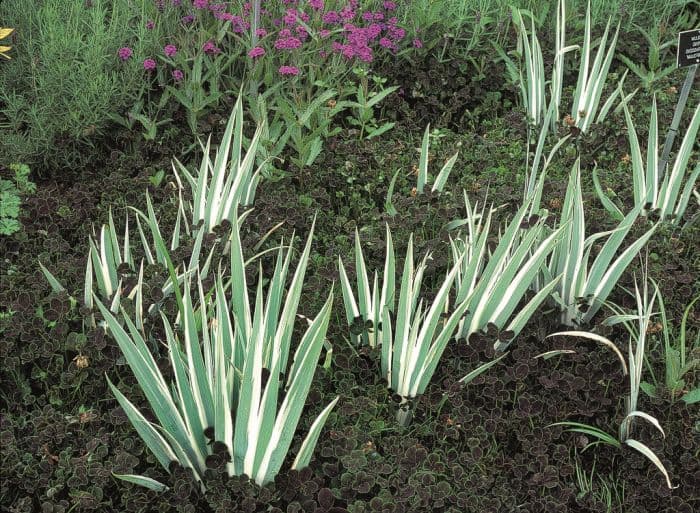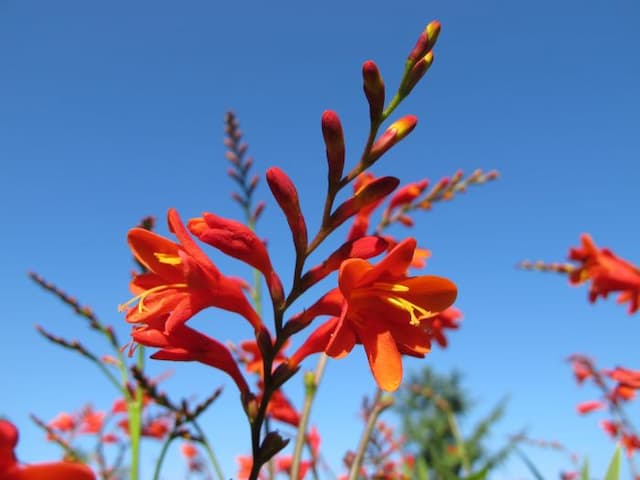Variegated Sweet Iris Iris pallida Lam. 'Variegata' Hort. (v)

ABOUT
The variegated sweet iris presents a striking appearance, primarily due to the distinctive patterning of its foliage. The leaves are sword-shaped, offering an elegant, upright structural element to gardens. Each leaf prominently features a blend of green and cream or yellow stripes running along its length, providing a lively variegated pattern that catches the eye. During the blooming period, the plant produces flowers that emanate a delightful fragrance, reminiscent of grapes, which is where one of its common names, the "sweet iris," comes from. These blossoms are usually a pale lavender or blue hue, adding a soft touch of color to the striking foliage below. The flowers are composed of three upright petals and three that arch downward gracefully, a characteristic known as "falls" in iris parlance. The variegated sweet iris is cherished not only for its ornamental foliage and sweet-smelling blooms but also for its resilience and adaptability in a variety of garden settings. The distinct foliage remains attractive even when the plant is not in bloom, ensuring it remains a focal point throughout the growing season. Its aesthetics make it an excellent choice for borders, accents, or as a feature plant in a perennial garden.
About this plant
 Names
NamesFamily
Iridaceae.
Synonyms
Dalmatian Iris, Variegated Sweet Iris, Zebra Iris, Variegata Sweet Iris.
Common names
Iris pallida Lam.
 Toxicity
ToxicityTo humans
The variegated sweet iris is generally considered to be mildly toxic if ingested. The main toxic components are the resinous compounds and isoflavones present in the rhizomes, which can cause digestive disturbances. Symptoms of poisoning from eating parts of the variegated sweet iris can include nausea, vomiting, abdominal pain, and diarrhea. However, it is unlikely to cause serious harm unless consumed in large quantities.
To pets
The variegated sweet iris contains compounds that can be toxic to pets if ingested, especially the rhizomes. Symptoms of poisoning in pets may include gastrointestinal upset, such as vomiting and diarrhea, drooling, and lethargy. It is important to prevent your pets from chewing on or ingesting any part of the iris to avoid these potential side effects. If you suspect your pet has consumed any part of the plant, consult a veterinarian.
 Characteristics
CharacteristicsLife cycle
Perennials
Foliage type
Deciduous
Color of leaves
Variegated
Flower color
Lavender
Height
2-3 feet (60-90 cm)
Spread
1-2 feet (30-60 cm)
Plant type
Herb
Hardiness zones
4-9
Native area
Dalmatia
Benefits
 General Benefits
General Benefits- Ornamental Value: The variegated foliage provides aesthetic appeal to gardens and landscapes.
- Drought Tolerance: Once established, it requires minimal water, making it suitable for xeriscaping.
- Low Maintenance: It does not require frequent care beyond occasional division to maintain its vigor.
- Attracts Wildlife: The flowers can attract butterflies and other pollinators, supporting local biodiversity.
- Tolerates Different Soils: It is adaptable to various soil conditions, including less fertile soils.
- Rhizomes for Perfumery: The rhizomes can be used in the production of orris root, which is used in perfumery and as a stabilizer in products.
- Erosion Control: The plant's root system can help stabilize soil and control erosion.
- Deer Resistance: It is generally resistant to deer, which makes it a good choice for gardens in areas with a large deer population.
- Seasonal Interest: It offers year-round visual interest with its variegated foliage and springtime blooms.
 Medical Properties
Medical Properties- This plant is not used for medical purposes.
 Air-purifying Qualities
Air-purifying QualitiesThis plant is not specifically known for air purifying qualities.
 Other Uses
Other Uses- Iris pallida 'Variegata' is often used as a border plant in gardens for its striking foliage that can add contrast and visual interest among green plants.
- The rhizomes can be used in perfumery as a source of iris butter or orris root, which has a violet-like fragrance.
- This iris is sometimes used in the art of pressed flower crafts due to its attractive bloom shape and color.
- Dried iris rhizomes are incorporated into potpourris and sachets for their scent and as a natural fixative for other fragrances.
- The robust leaves can be used in floral arrangements, especially in more modern or architectural designs where their striping is appreciated.
- Iris fibers, taken from the leaves, can be used in paper making to create textured and decorative papers.
- The bloom's striking appearance makes it a popular choice for botanical illustration and watercolor painting.
- This iris's distinct variegation can be inspiring in landscape design, influencing patterns and arrangements in garden mosaics and stonework.
- Culinary artists sometimes use the edible flowers of Iris pallida 'Variegata' to garnish desserts and salads for an artistic presentation.
- The plant plays a role in educational gardens, where it's used to teach about plant variegation and the importance of pollinators.
Interesting Facts
 Feng Shui
Feng ShuiThe Variegated Iris is not used in Feng Shui practice.
 Zodiac Sign Compitability
Zodiac Sign CompitabilityThe Variegated Iris is not used in astrology practice.
 Plant Symbolism
Plant Symbolism- Hope: Iris is often associated with hope, reflecting its role as a herald of spring.
- Wisdom: The iris carries a message of wisdom due to its namesake, the Greek goddess Iris, who was a messenger of the gods and personification of the rainbow.
- Valor: The iris, particularly its blade-like leaves, signifies valor and bravery, as well as the idea of having a 'sharp' mind.
- Compliments: In the language of flowers, the iris can be given as a compliment to someone's beauty or to convey an eloquent message.
- Faith: Its resilience and perennial nature make the iris a symbol of faith and belief in the future.
- Royalty: Historically, the iris has been associated with royalty and dignity, especially the purple varieties that resemble the color of royal robes.
 Water
WaterThe Zebra Iris, commonly known as Iris pallida 'Variegata', should be watered deeply once a week, providing about 1 inch of water which would translate to roughly 0.6 gallons per square foot, if the weather is dry. During hot, dry spells, watering may need to increase to twice a week. Always check the soil moisture; the top inch should be allowed to dry out before watering again. Over-watering can lead to root rot, so ensure good drainage. In cooler weather or during rainy seasons, reduce watering frequency accordingly to prevent soggy soil.
 Light
LightThe Zebra Iris thrives best in full sun to partial shade. Ideally, it should receive at least six hours of direct sunlight each day, making an east- or west-facing location in the garden suitable for its growth. If planted in too much shade, the plant may not bloom as vigorously.
 Temperature
TemperatureZebra Irises prefer temperate climates and perform best when the temperature ranges between 68°F and 86°F. They can withstand temperatures as low as 14°F in winter months and should not be exposed to temperatures over 95°F for extended periods as it may stress the plant. The ideal growth conditions are in areas where the nights are cool, and the days are moderately warm.
 Pruning
PruningPruning Zebra Irises involves removing any dead or damaged leaves and spent flower stalks to promote healthy growth and prevent disease. This should be done after blooming, typically in late summer. However, avoid cutting back the healthy green leaves as they provide energy for the next year's growth. Remove any debris from around the plant to maintain good air circulation.
 Cleaning
CleaningAs needed
 Soil
SoilThe best soil mix for the Dalmatian Iris is well-draining, moderately fertile and slightly acidic to neutral, with a pH of 6.5 to 7. A combination of loamy garden soil, compost, and sand or perlite can provide the appropriate structure and nutrients. Ensuring good drainage is key, as the rhizomes are prone to rot in overly wet conditions.
 Repotting
RepottingDalmatian Iris typically doesn't need frequent repotting and can be divided every 3 to 5 years during post-bloom dormancy to manage space and rejuvenate the plant's vigor. Ensure each division has at least one healthy fan of leaves and a portion of the rhizome.
 Humidity & Misting
Humidity & MistingDalmatian Iris performs well in average garden humidity levels and does not require specific humidity conditions. It is adaptable to the ambient humidity found in most temperate climates and does not thrive in excessively humid environments.
 Suitable locations
Suitable locationsIndoor
Place Dalmatian Iris in bright, indirect light; keep in a cool spot.
Outdoor
Plant in well-draining soil, full sun to partial shade.
Hardiness zone
4-9 USDA
 Life cycle
Life cycleIris pallida 'Variegata', commonly known as Variegated Sweet Iris, begins its life as a rhizome, a horizontal stem from which roots and shoots emerge. In spring, shoots grow into stiff, sword-like, variegated leaves while flower stalks develop, culminating in fragrant, light purple flowers. After flowering, usually between late spring and early summer, the plant enters a period of photosynthesis and energy storage in the rhizome. Throughout the summer, the leaves continue to photosynthesize, contributing to the growth of the rhizome underground. With the onset of fall, and less favorable weather, the plant's above-ground foliage starts to die back, and the iris enters a period of dormancy during the winter. In the following spring, the cycle begins anew with the growth of new leaves and flowers, while the plant may also undergo vegetative reproduction as the rhizome grows and produces offsets, leading to the spread of the plant.
 Propogation
PropogationPropogation time
Early spring
The most popular method of propagation for Iris pallida 'Variegata', also known as the Variegated Sweet Iris, is through division of its rhizomes. This is best done in late summer after the flowering season has finished or in early fall. Gardeners should carefully dig up the clumps of iris and rinse or brush off the soil to see the rhizomes clearly. Using a sharp knife, they can cut the rhizomes apart, ensuring that each section has at least one fan of leaves and good root development. The cuts should be made a few inches away from the leaves, typically 3 to 4 inches (about 7.5 to 10 centimeters), to leave enough rhizome to nourish the new plant. The divided pieces can then be replanted in well-draining soil at the same depth they were growing previously, positioning the fans of leaves away from the midday sun. It's important to water the newly planted divisions well to help them establish.









